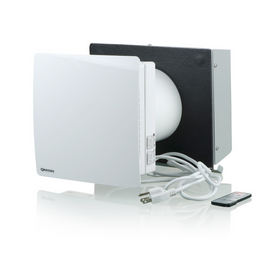
Embodied Energy in the Home
Last Updated: Mar 20, 2025Sustainable, "green," or environmentally friendly homes are usually associated with solar panels, LED lights, and energy-efficient appliances. Reducing the amount of energy our homes use and incorporating renewable energy sources are essential elements of lowering our carbon footprint. (Check out this Rise article for how you can easily calculate your carbon footprint).
However, what if we told you that the energy used in building the homes we live in often contributes much more to global climate change and other aspects of environmental degradation?
Embodied energy is not discussed often in conversations around the sustainable home sector. However, suppose we are going to commit to living in more sustainable and regenerative homes. In that case, we need to make an effort to understand the total energy footprint of the buildings we inhabit. Below, we look at what embodied energy is, how to calculate it, and simple things that every homeowner can do to reduce the embodied energy footprint of our homes.
Table of Contents
- Climate Change and Resource Consumption Awareness
- What Is Embodied Energy?
- Why Should I Care About Embodied Energy?
- How is Embodied Energy Calculated?
- What Can You Do to Lower the Embodied Energy of Your Home?

Climate Change and Resource Consumption Awareness
According to a 2019 poll released by Yale University and George Mason University, almost seven out of every ten Americans are at least "somewhat worried" about the threats posed by global climate change. For years, climate change was mostly seen as a distant threat that would have limited consequences, at least during the lifetimes of the current generation. However, extreme weather events are becoming a regular occurrence. And, more difficult scientific predictions regarding the scope and rate at which climate change is progressing have been released in recent years. This increased awareness has led to changes in attitude towards the most severe environmental challenge we face.
Despite this growing public concern, many people still feel relatively powerless regarding strategies to combat climate change. Flying less or purchasing an electric car can certainly reduce individual carbon footprints. Nevertheless, the homes we live in are often the most significant contributors to the carbon emissions associated with our lifestyles. The EPA states that in 2018, direct greenhouse gas emissions emitted from homes and businesses accounted for over 12 percent of total US greenhouse gas emissions due to their energy demand. So, investing money in energy-efficient, low-carbon retrofits for your home is a simple way to cut back on the "operational emissions" of your home over time.
But what about the energy used to build the homes that we inhabit? Say a homeowner went completely net-zero energy through installing a 7 KW solar PV system and investing in passive house retrofits. The energy used to source and transport the materials for that home would already have contributed to an enormous amount of greenhouse gas emissions.

What Is Embodied Energy?
The International Journal of Sustainable Built Environment considers embodied energy to be the total amount of energy consumed during the production of a residential or commercial building.
Think about the embodied energy in your home. Look around and review all of the different materials and products used to make the finished product. The granite in your kitchen countertop required an enormous amount of energy to be mined from a stone quarry. The power used to cut down the trees and mill the lumber for the 2x4s and flooring in your living room similarly came with substantial energy requirements. The foam insulation that improves the energy efficiency of your basement and home foundation also required an enormous amount of energy to produce.
The embodied energy footprint of a home is calculated by considering the energy used during:
- Mining and acquisition of natural resources
- Manufacturing and other industrial processes of transforming raw resources into usable building components
- Transportation of building materials from their source of origin to your home
- Energy used during the building process itself
- Energy used to operate the home during its lifetime

Why Should I Care About Embodied Energy?
In many ways, the embodied energy in the homes we live in might seem like an aspect of home sustainability that is simply out of the scope of our responsibility. To reduce energy usage, every homeowner can choose to complete upgrades like installing a more energy-efficient refrigerator, installing triple-pane windows, or maybe even installing solar panels. Behavioral change (such as turning off the lights and adjusting the thermostat accordingly) is also a tangible way to increase our homes' operational efficiency. But, can we be accountable for the amount of energy used to mine and manufacture the cement used in the foundations of our home?
Unlike operational efficiency (i.e., the amount of energy and electricity our homes use to keep us comfortable), the embodied energy is not occupant dependent. Still, every homeowner should be concerned about the energy that went into the materials in our homes. Why? Because this "upstream" component of the lifecycle impact of our homes might be equivalent to decades of the operational energy use of our homes.
A landmark study titled "The Greenest Building: Quantifying the Environmental Value of Building Reuse" was published in 2012. The study found that it can take between 10 and 80 years for an energy-efficient new building to offset the negative climate change impacts that came from the embodied energy of the building process. The study found that an energy-efficient, single-family home built in Portland, Oregon, would take 50 years of energy savings to offset the embodied energy of the home's construction.
The World Green Building Council published an important report in 2019. They stated that 11 percent of global carbon emissions stem from the materials and construction processes that occur during the building's lifecycle.
To date, most strategies to "green" the building and construction sector have focused almost exclusively on improving operational efficiency. Today, however, the World Green Building Council and other leaders in the industry are dedicated to incorporating strategies to eliminate embodied carbon emissions.
How is Embodied Energy Calculated?
One of the biggest challenges that come with understanding the embodied energy footprint of our homes is that embodied energy is calculated in a very sophisticated way. To discover the operational efficiency of your home, homeowners can quickly find a carbon footprint calculator on the internet and devise a plan to reduce overall energy demand. However, an embodied energy analysis for the steel beam in your ceiling needs to consider the amount of energy used to mine steel, manufacture it into a usable product, transport it to your home site, and any energy used in raising it and welding it into place.

In mathematical terms, embodied energy is measured by the quantity of non-renewable energy per unit of building material. The embodied energy of each material used in your home is conveyed in megajoules (MJ) or gigajoules (GJ) per unit weight (kg or ton) or area (m2). To try and make this a bit clearer, the Australian government has calculated synthetic rubber to have an embodied energy rating of 110 (measured in MJ per KG). At the same time, air-dried sawn hardwood has a rating of just 0.5 MJ/kg. The lower the score, the less embodied energy in the building material.
You can find a more detailed list of the embodied energy rating or the coefficient of a large number of building materials here.
What Can You Do to Lower the Embodied Energy of Your Home?
All this talk about mega joules might make you want to dig out your old high school chemistry book to try and understand how embodied energy is measured. Or, maybe advanced chemistry and math are not your things! Fortunately, several "principles of action" can help every homeowner reduce the embodied energy footprint of their homes.

Renovate Instead of Rebuild to Reduce Embodied Energy
Building a new home will require enormous materials, all of which have large amounts of embodied energy. Even replacing an older, less energy-efficient home with a modern, net-zero home will generally take several decades to offset. Carl Elefante, a leading architect who considers the embodied energy footprint of a building, once said that "the greenest building is the one already standing."
Opt for Durable Building Materials to Reduce Embodied Energy
Unfortunately, many buildings today are constructed with inferior and substandard materials that have relatively short expected lifespans. Every time you have to replace your carpet, insulation, or drywall, the embodied energy footprint of your home will increase. Thus, investing more upfront for materials that are durable and long-lasting should be a priority.
Prioritize Local Products to Reduce Embodied Energy
Wooden flooring made from exotic hardwood species will most likely have a higher embodied energy footprint than a product made by a local manufacturer from locally harvested timber. The energy cost of transporting building materials long distances adds to the embodied energy of every building material, especially if they are heavy or bulky. When purchasing building materials for a home renovation, check the origin of the product and prioritize relatively close materials to your building site.

Natural Materials over Synthetics to Reduce Embodied Energy
Synthetic and human-made materials almost always have a higher embodied energy footprint than natural products. For example, consider the embodied energy footprints of the following types of insulation according to the chart we referenced above:
- Cellulose insulation (cotton): 3.3
- Recycled sheep's wool: 14.6
- Fiberglass: 30.3
- Polyester: 53.7
Incorporate Recycled or Reclaimed Materials into Your Home Renovations to Reduce Embodied Energy
Homeowners should also attempt to incorporate recycled materials into their home renovation plans as often as possible. Many of these, like salvaged hardwood flooring, recycled paper countertops, are becoming much more accessible to source from mainstream manufacturers. These and other products containing recycled materials reduce the mining or acquisition of raw materials, a considerable component of embodied energy in building materials.

Considering the embodied energy footprint of your home might seem impossible at first. However, the suggestions mentioned above are simple ways that every homeowner can reduce the embodied energy of the homes we inhabit.
Tobias Roberts
Tobias runs an agroecology farm and a natural building collective in the mountains of El Salvador. He specializes in earthen construction methods and uses permaculture design methods to integrate structures into the sustainability of the landscape.










